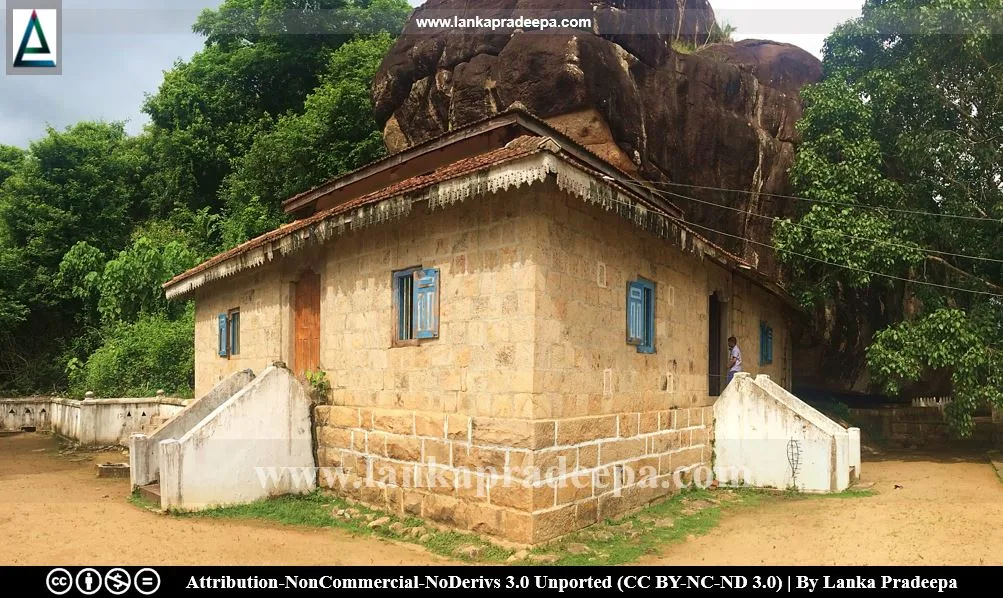
Mayurawathi Raja Maha Viharaya (Sinhala: මැටියගනේ මයුරාවතී රජ මහා විහාරය) is a Buddhist temple located in the village of Metiyagane in Kurunagala District, Sri Lanka.
History
Folklore
The history of the Mayurawathi temple, according to locals, goes back to the Anuradhapura Period (Anuradha & Kumari, 2015). It is believed that this temple was established at the invitation of Mayurawathi Deviya, the daughter of King Devanampiyatissa [(247-207 A.D.) Anuradha & Kumari, 2015].
Matiyagane rock inscription
A rock inscription belonging to the 1st century A.D. has been found on the temple premises. It reveals the name "Mati Vihara" which is evidently the name of the monastery which existed here in ancient times (Paranavitana, 2001).
This inscription was copied by the Department of Archaeology in 1928 (Paranavitana, 2001). Written in the Later Brahmi Scripts of about the 1st century A.D., the record consists of three lines of writing (Paranavitana, 2001). The purpose of the record was to grant the income of a certain tank to the Sangha (Buddhist monks) of Mati vihara (Paranavitana, 2001).
Period: 1st century A.D.
Script: Later Brahmi
Language: Old Sinhala
Content: This inscription records the donation of two types of taxes from the Kadahaka tank and from the place known as Silaviya to the resident monks of the Mati Vihara.
Reference: The information board at the site by the Department of Archaeology and the Ministry of National Heritage.
Royal patronage
It is said that Metiyagane Viharaya was the temple where Buddhaputra Sthavira of Mayurapada Pirivena, the author of the Pujavaliya (a Sinhalese classic written in the 13th century), lived (Anuradha & Kumari, 2015). According to local tradition, this temple has been renovated by several rulers from time to time. The name of this temple is mentioned in a copper plate issued in 1429 by King Parakramabahu VI (1412-1467 A.D.) of the Kotte Kingdom (Siriwardana & Jayakody, 2017). It is said that Mayuravathi, the grandmother of Parakramabahu VI bestowed the temple to a Buddhist monk named Devarakkhita Thera of the Dambadeni Mahimi Bandara lineage (Siriwardana & Jayakody, 2017).
A silver plate grant issued in 1675 by King Rajasinghe II (1635-1687 A.D.) of the Kandyan Kingdom also reveals that the king had added a new section called Uda Maluwa Viharaya to this temple and bestowed it to a Buddhist monk named Gunadahe Dammadassi Thera of Asgiri Maha Viharaya (Siriwardana & Jayakody, 2017).
The temple
Several rock caves with drip ledges used by meditating monks in ancient times are found on the temple premises. The main image house of the temple is situated under the shade of a large rock cave located on a high terrace. The walls and the main door frame of it are made of stone. The original clay floor of the image house has been cemented recently (De Silva & Chandrasekara, 2009). The roof has two levels and is covered with clay tiles. Inside the image house, a small Stupa and three statues of Buddha in Samadhi, reclining, and standing postures are found.
The small Stupa in the image house
Small Stupas are believed to have been built in Sri Lankan temples during the 5-10 centuries A.D. (Anuradha & Kumari, 2015). The small Stupa in the image house of the Mayurawathi temple is said to have been erected to commemorate Mayurawathi Deviya whose jewellery, according to folklore, has been enshrined inside it (Anuradha & Kumari, 2015; De Silva & Chandrasekara, 2009). However, the dome of the Stupa has been destroyed by treasure hunters in the recent past in search of treasures hidden inside it.
A protected site
The rock with the inscription, ancient image house, and drip-ledged caves located in Metiyagane Mayurawathi Raja Maha Vihara premises in the Divisional Secretary’s Division, Narammala are archaeological protected monuments, declared by a government Gazette notification published on 27 July 2001.



.
References
1) Anuradha, R.K.S.; Kumari, A.S., 2015. Pauranika Sthana Saha Smaraka: Kurunegala Distrikkaya (In Sinhala). Department of Archaeology (Sri Lanka). ISBN: 955-9159-37-2. pp.25-26.
2) De Silva, N.; Chandrasekara, D.P., 2009. Heritage Buildings of Sri Lanka. Colombo: The National Trust Sri Lanka, ISBN: 978-955-0093-01-4. p.74.
3) Paranavitana, S., 2001 (Edited by Dias, M.). Inscriptions of Ceylon: Vol. II. Part II. Archaeological Survey Department, Sri Lanka. pp.284-285.
4) Siriwardana, S.; Jayakody, K.M., 2017. කුරුණෑගල, මයුරාවතී රජමහ විහාර සෙල්ලිපිය පිළිබඳ අධ්යයනයක්. URSARU, Department of Archaeology and Heritage Management. University of Rajarata. pp.239-240.
2) De Silva, N.; Chandrasekara, D.P., 2009. Heritage Buildings of Sri Lanka. Colombo: The National Trust Sri Lanka, ISBN: 978-955-0093-01-4. p.74.
3) Paranavitana, S., 2001 (Edited by Dias, M.). Inscriptions of Ceylon: Vol. II. Part II. Archaeological Survey Department, Sri Lanka. pp.284-285.
4) Siriwardana, S.; Jayakody, K.M., 2017. කුරුණෑගල, මයුරාවතී රජමහ විහාර සෙල්ලිපිය පිළිබඳ අධ්යයනයක්. URSARU, Department of Archaeology and Heritage Management. University of Rajarata. pp.239-240.
5) The Gazette of the Democratic Socialist Republic of Sri Lanka. no: 1195. 27 July 2001.
Location Map
This page was last updated on 14 January 2023


